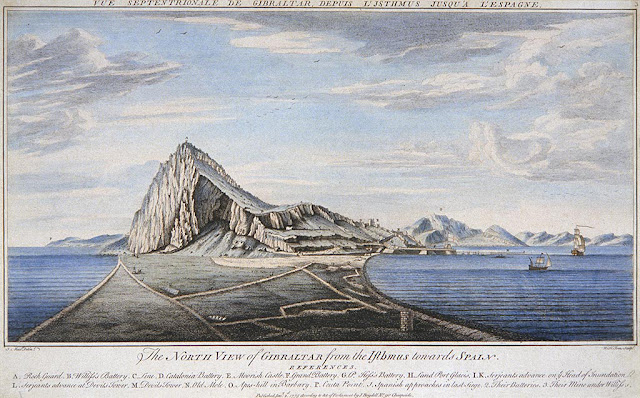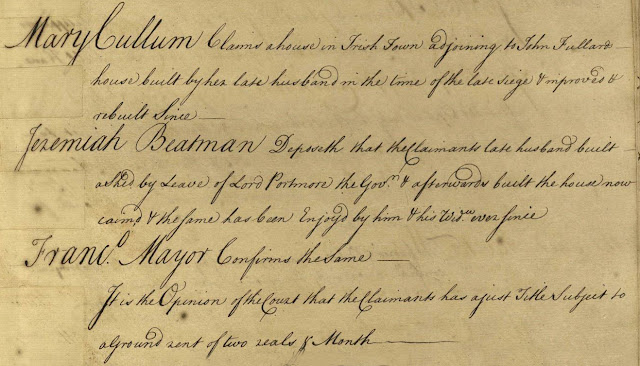The Rock of Gibraltar in the early 18th century ( W. H. Toms )
Throughout his term of office Governor William Hargrave employed a certain Captain John Fleming as his private secretary who by all accounts was an even greater scoundrel than his master. One of the more notorious cases involving this officer was that of Alice Cullum, a young British girl who was a resident of Gibraltar during the early 18th century.
It is a story that has proved irresistible to many historians who have invariably included it in their discussions of this rather interesting era within the social history of the Rock. It has certainly proved irresistible to me so here it is once again as I understand it.
I am not sure when James Cullum - Alice’s father - first came to Gibraltar but there are records that show that David Colyear, the 1st Lord Portmore and the Governor of Gibraltar at the time gave him permission to build a shed in Irish Town during or shortly after the 13th Siege of Gibraltar. The shed was later converted into a house.
David Colyear, the 1st Lord Portmore
Nor can I find any information as to how James earned his keep on the Rock. He might have been a retired soldier although he could just as likely have been a tradesman of some sort or the other. What I do know is that he was married to a woman called Mary and that their daughter Alice appears to have been their only child.
The story goes that John died in the 1730s - possibly in 1739 - and that his wife inherited the house. Mary Cullum herself died in 1744 and Alice - who was 14 or 15 years old at the time of her mother’s death - inherited the property along with a few debts. By all accounts both she and her grandmother continued to live in her father’s property and apparently renting out some of the rooms they no longer had need for themselves. A local resident Esperanza Valle lived in one of those rooms from 1739 to 1745.
It was not long after Mary had passed away that Captain Fleming happened to meet Alice in Main Street and had a so-called wee chat with her. Condolences presumably and hypocritically given he made Alice what he must have considered an extremely generous offer -
“I am sorry to hear that you are having problems and I would like to help. Why don’t you come and live with me as my housemaid? I will pay off all your debts so that you can then properly own the house you and your Gran are living in. I will even throw in an extra property for you” - or words to that effect.
Alice, who comes across as having been both pretty and principled, indignantly refused what she quite rightly interpreted as an indecent proposal. A few months later she found that her tenants were refusing to pay. When she asked for an explanation she was told that they had been instructed by Captain Fleming to pay their rent to Isaac Espinosa, a local Jewish merchant.
Off she went to see Fleming to find out what on earth was going on. The Captain, however, offered no explanation and simply repeated his original proposals. Alice refused yet again and a month later he managed to have her arbitrarily imprisoned for ‘three day and three nights without any particular cause’ in the ‘Lady’s Hole’, which was probably a part of a notoriously unpleasant dungeon on the south-east corner of the Grand Parade in the middle of town known as the ‘Black Hole’. When her grandmother who was 80 years old at the time tried to intervene she too was sent to the same prison that Alice was in.
Off she went to see Fleming to find out what on earth was going on. The Captain, however, offered no explanation and simply repeated his original proposals. Alice refused yet again and a month later he managed to have her arbitrarily imprisoned for ‘three day and three nights without any particular cause’ in the ‘Lady’s Hole’, which was probably a part of a notoriously unpleasant dungeon on the south-east corner of the Grand Parade in the middle of town known as the ‘Black Hole’. When her grandmother who was 80 years old at the time tried to intervene she too was sent to the same prison that Alice was in.
Grand Parade in the 1750s - the Blackhole bottom left ( 1771 - Thomas James - detail )
A year later, Espinosa began to build himself a warehouse on part of the premises and once again Alice’s grandmother told Espinosa that the ground was not his and that he had no right to build anything on it, the Jewish merchant complained directly to Governor Hargraves who promptly put her in prison for another three day and three nights in the “Black Hole”.
William Hargrave
When she took finally managed to take her case to a Board of Enquiry the Court’s recorder found it hard to disguise Hargrave’s arbitrary disdain for the any kind of justice. He had told her that ‘he would transport and do as he pleased with her and that by God she would never have possession of the house as long as he commanded the Garrison.
The old lady then asked for leave to see Hargrave so that he might explain what it was that she had done that had made him send her to prison. Not surprisingly the Governor refused to see her but sent her a thoroughly impertinent message which more or less stated that he could do whatever he pleased and that “by God” she would never have possession of the house while he was in command of the Garrison.
And that was about that. In so far as the Cullums were concerned they could kiss their property goodbye. Fortunately the story does have a happy ending - Hardgrave had gone too far in lining his pocket with money that theoretically belonged to his King. He was eventually recalled to England in 1748 and was replaced by Humphrey Bland.
Humphrey Bland
The new Governor while not quite the paragon of virtue some made him out to be was certainly an improvement on Hargrave. For a start he conveniently set up a Court of Enquiry into Property Grants at Gibraltar which allowed property owners to lay claim to lands and buildings that they wished to have confirmed as their own. The Cullums were unfortunately rather slow on the uptake. They were beaten to it by Isaac Espinosa who was speaking on behalf of the heirs of Jacob Fernandez Escudero and Moses Espinosa - who may have been Isaac’s father. The diseased - Isaac argued - had actually bought the two houses in Irish Town from James Cullum.
From the minutes of the Court of Enquiry - September 1749
Alice, however, argued that the house had not been sold but mortgaged for 99 year to Escudero and Espinosa. Once the mortgage had been repaid the Governor of the day - Joseph Sabine - had granted them the right of ownership of the two houses.
From the minutes of the Court of Enquiry - September 1749
Note the reference to “two houses” - James Cullum must have extended the original shed into a proper building and then perhaps constructed another house beside it. My guess is that by 1749 Alice and her grandmother lived in one and rented out the other.
For what was to be the one and only time in the entire two months of the proceedings the Court decided that one of the claimants - the Cullums - had not been sufficiently prepared and judgement was postponed for a further hearing.
From the minutes of the Court of Enquiry - First hearing - postponed
The Court seems to have been under the impression that Alice’s grandmother was actually her mother. During the second hearing which took place about a month and a few days later, Alice swears under oath that her mother died in 1744.
From the minutes of the Court of Enquiry - Final hearing
One can easily interpret the above as a mistake by Court’s secretary - but there might be more to it than that. Alice made her original claim on Friday the 1st of September 1749. On Monday the 4th somebody called Mary Cullum made separate claim for a house in Irish Town built by her late husband during 1725 with the permission of Lord Portmore. The house stood next to that of John Fullard and had been rebuilt since.
From the minutes of the Court of Enquiry
Two other residents, Jeremiah Beatman and Franco Mayor confirmed her deposition and the Court acknowledged her right to the house. The question of course is - if Alice’s mother was dead who the hell was this other Mary Cullum also living in Irish Town. Curiously, when John Fullard and Franco Major also made claims for their own houses in Irish Town, both told the court that their properties were next to a house belonging to the Widow Cullum.
Whatever might be the answer to the above conundrum, the story has a happy ending. In a lengthy and somewhat Solomonic judgement the Board was of the opinion that the amount supposedly paid by Espinosa et al for the 99 year lease did not correspond with the value of the property. They therefore ordered Alice to repay the mortgage plus a 10% interest over the intervening years, the total being offset by whatever rents the merchants had received over that time. The end result was a small balance payable by Alice. In essence the Court had found in her favour and restored her property.
As regards Fleming by 1749 he was no longer in Gibraltar - despite the fact that he still owned a large number of properties there. The Captain had followed Hargrave to England and was rewarded for his loyalty by inheriting the bulk of the ex-Governor’s estate when he died shortly afterwards.
Whatever might be the answer to the above conundrum, the story has a happy ending. In a lengthy and somewhat Solomonic judgement the Board was of the opinion that the amount supposedly paid by Espinosa et al for the 99 year lease did not correspond with the value of the property. They therefore ordered Alice to repay the mortgage plus a 10% interest over the intervening years, the total being offset by whatever rents the merchants had received over that time. The end result was a small balance payable by Alice. In essence the Court had found in her favour and restored her property.
As regards Fleming by 1749 he was no longer in Gibraltar - despite the fact that he still owned a large number of properties there. The Captain had followed Hargrave to England and was rewarded for his loyalty by inheriting the bulk of the ex-Governor’s estate when he died shortly afterwards.










